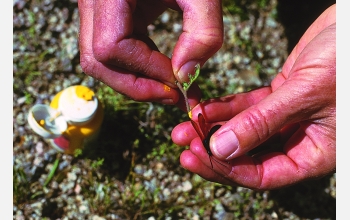Multimedia Gallery
Tarantula Hawk Wasp Marked With Paint
A male tarantula hawk wasp is marked with acrylic paint for a research study on insect mating strategies. Fortunately for biologists, male wasps don't sting. [Image 2 of 2 related images. See Image 1.]
More about this Image
John Alcock, a regent's professor of biology at Arizona State University, has been studying the mating practices of the tarantula hawk wasp in the Usery Mountains in Arizona for many years. These wasps get their name from preying on tarantulas and other large spiders. Female hawk wasps have long, powerful stingers. When they are ready to lay an egg, they will seek out a spider--the bigger sized the better, sting and paralyze it, then lay a single egg on the spider's body. The female wasp will then drag the spider back to it's own burrow or bury it in a hole. When the larva hatch a few days later, a massive meal is waiting and they will slowly eat the spider alive. The size of the spider on which the egg is laid will determine the size of the adult wasp. The larger the spider the larger the meal, and the bigger the wasp will grow. This is very important because it is the size of the male wasp that will ultimately determine whether or not he will find a mate.
The mating territories of the tarantula hawk wasp are along aplo verde-studded ridges. When mating time arrives, female wasps fly uphill to the highest point, where the males will meet them. Alcock has found that competition for these peak, top territories is fierce and it is the larger males that almost always win, creating a serious problem for the smaller males.
The male wasps fall into different categories, depending on their size. The largest wasps--which can measure almost two inches long--will stake their claim in prime mating territory in trees along the top mountain ridges. The smaller males--which are sometimes less than half an inch long--tend to occupy lower, less attractive sites where females are in short supply. A second group of smaller males are vagabonds, and wander among other males' territories, rather than make any particular tree or shrub their home. They may attempt to intercept females on their way to the top. Sometimes, a particularly confident mid-size male hawk wasp may try to oust a bigger wasp from his roost, and if in good condition, may even win the challenge. These encounters can escalate into dramatic battles. The wasps don't grapple or wrestle but instead, engage in ritualized aerial displays that Alcock says are spectacular to watch. They may race upwards of over 100 feet, all the while spiraling around each other, then stop mid air and dive back down to the tree. When they are serious about winning, these upward spiral flights can number in the hundreds and last up to an hour.
The National Science Foundation supports ASU research on insect mating strategies.
Credit: John C. Phillips, Arizona State University
Images and other media in the National Science Foundation Multimedia Gallery are available for use in print and electronic material by NSF employees, members of the media, university staff, teachers and the general public. All media in the gallery are intended for personal, educational and nonprofit/non-commercial use only.
Images credited to the National Science Foundation, a federal agency, are in the public domain. The images were created by employees of the United States Government as part of their official duties or prepared by contractors as "works for hire" for NSF. You may freely use NSF-credited images and, at your discretion, credit NSF with a "Courtesy: National Science Foundation" notation.
Additional information about general usage can be found in Conditions.
Also Available:
Download the high-resolution TIFF version of the image. (3.1 MB)
Use your mouse to right-click (Mac users may need to Ctrl-click) the link above and choose the option that will save the file or target to your computer.

